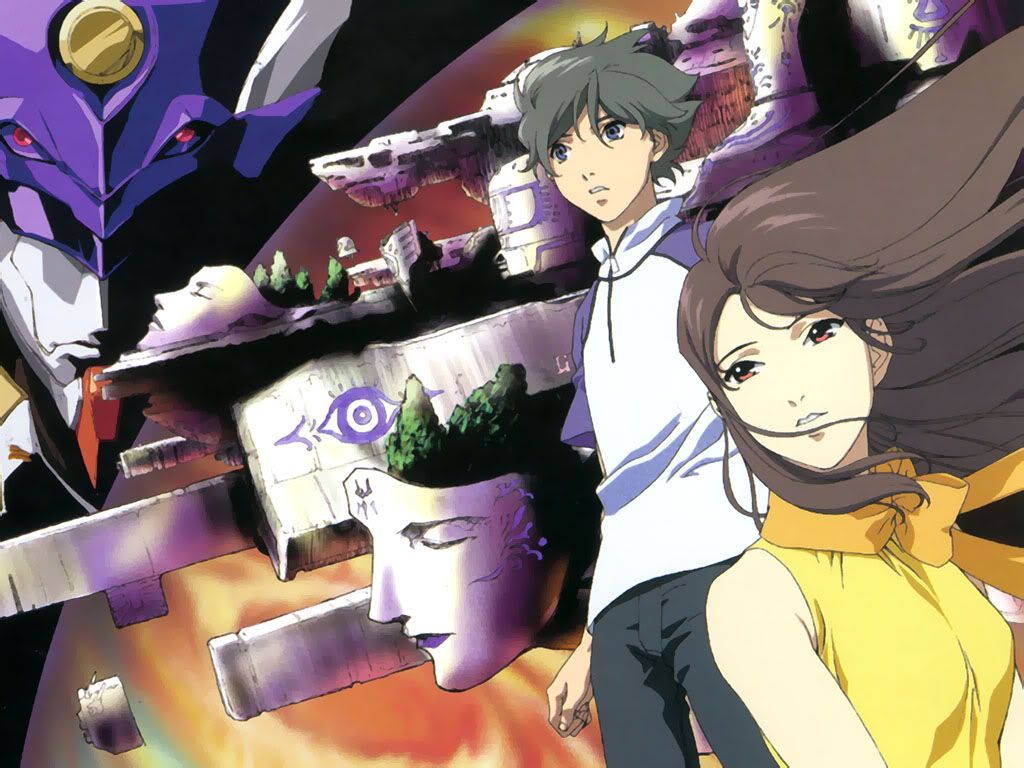Earlier in the year one of the people in my local anime club brought this in to show for Fantasy Night (yes I know, we have a very hard time figuring out what genre things belong to) which we ended up watching and I enjoyed the first three episodes so I asked if I could borrow it some time and he loaned to to me right there. Awesome, I tried out NGE earlier in the year but wasn't so keen on it so I was really curious about how much I would like this series, I've often heard it described as "Eva but with music and happy" which sounded like an interesting change and even three episodes in it had proven to be way more symbolism heavy than Eva ever was.
RahXephon
Summary: As far as Ayato Kamina knows, it's 2015 and Tokyo is the only part of the world that's still around after a mysterious barrier surrounded the city and enclosed it years ago. This isn't the case however and as he escapes to the outside world Ayato realizes just how much of his life has been a fabrication.
The Good: I was disappointed when Neon Genesis Evangelion did not have as much symbolism and such as I was lead to believe and I was happily surprised to see just how much RahXephon did have. I love it when a scene has multiple meanings for me to puzzle over and there were many things in this show that were only shown or implied instead of outright told and I liked that, it worked well with the series. The ending also surprisingly worked well, if it hadn't had the very last scene I would have been really unhappy with it but the writers took pity on the fans and threw in that extra scene. Overall I found the writing to be really good, I nice mix of everyday life and of the important matters going on behind the scenes and the story seemed to explain all of it's background without the need for extra media so kudos to the writers for this one.
The Bad: I felt like things started becoming a bit too complex by the end of the story and at points it was hard to tell what was going on. In addition, several characters either reappear or have their backstory fleshed out and I was skeptical at just how much they had changed in that time which bothered me. Unless a story spends a lot of time following a character and fleshing them out this often bothers me but it did bother me regardless. It was also a bit hard at times to keep dates and character relations (as in, who is related to whom) straight but I suspect that that was deliberate on the anime's part.
The Audio: For a show that uses music as a major theme I didn't really notice much music (either as background or produced by the characters) until very late in the show and I was listening very carefully for it. Once the musical symbolism gets going it's there all the time but I do wish it had been incorporated a little more heavily into the early parts. Didn't really care for the ending theme but I loved the opening theme, both the melody and the lyrics and now it's probably one of my favorite OPs.
The Visuals: The show is nearly a decade old so the colors aren't as vivid as something produced today but honestly that doesn't detract from the series, there's plenty of strange imagery on screen and interesting designs to make the series visually interesting. It's not so much the artistic talent that went into the show but just what was on the screen that was so interesting, lots and lots of symbolism that wouldn't work quite so well in an all print (or all audio) medium. It's a show where it makes sense that it was produced as a show and that does mean the show has succeeded on at least one level.
So the next time someone tells me that NGE is filled with symbolism and it's soooo deep I'm going to make them watch this series instead (or Utena but that comparison doesn't work quite as well). I plan on getting the series someday, it does sell really cheaply everywhere online but I'm less than thrilled that it's in two stack pack sets. Not quite as bad as my Moribito set but I guess I'll also have to make plans to deal with that when I get the set.
